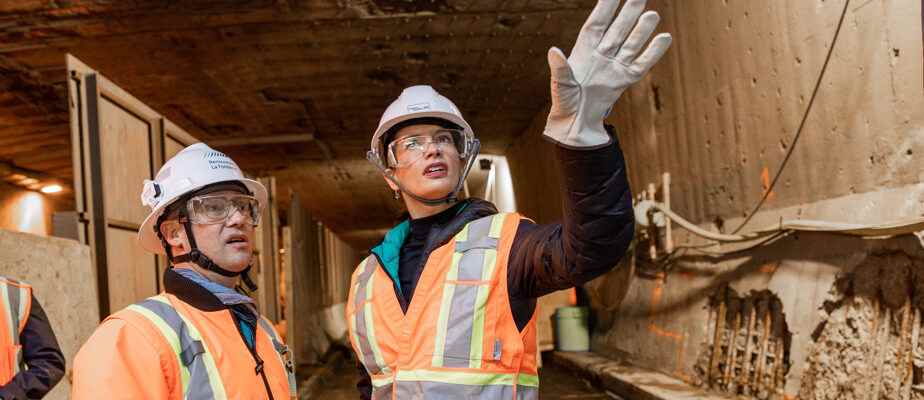Three days before the three-year closure of half of the lanes in the Louis-Hippolyte-La Fontaine tunnel, the new Minister of Transport and Sustainable Mobility, Geneviève Guilbault, wants to be reassuring. Everything is in place to ensure the least catastrophic congestion scenario possible, she assures. But she admits it: everything will also depend on the choices of the population in the long term.
Posted at 5:00 a.m.
“We have a huge project ahead of us, but there is a lot of expertise and investment around it. There was no improvisation. If we are able to do it, it’s because we have so many people working hard. And I wouldn’t want these people to feel demoralized, feeling like we’re not ready. It’s quite the opposite,” says M.me Guilbault in interview with The Press.
More and more voices are being raised to criticize the insufficiency of the measures in place, the lack of coordination or even the little time that Quebec has left for the population to adapt.

PHOTO MARTIN TREMBLAY, THE PRESS
Preparatory works in the Louis-Hippolyte-La Fontaine tunnel
But the minister believes on the contrary that the government has done a “very good job”, in the context, to minimize the impacts. “Certainly, there is a communication challenge. There’s always one, and especially every few days. But we made sure that our communications are well done, that we offer everything we can offer, that the message gets across well throughout the municipalities,” summarizes the Minister.
With everything we’ve done, we’re able to transport thousands more people by public transit.
Geneviève Guilbault, new Minister of Transport and Sustainable Mobility
Mme Guilbault, however, finds it unfortunate that only one lane will remain on the Victoria Bridge until the end of November, one of the main crossings between the South Shore and Montreal. “It is sure that it is flat, a bit like the REM which has been postponed. But these are realities that are beyond our control, with which we have no choice but to deal, ”she said Thursday in a press scrum.
An opportunity to change
The one who is also Deputy Prime Minister describes the partial closure of the tunnel as a “real opportunity”. Within three years, she hopes that certain incentive measures for public transit linked to the construction site will be “maintained” in order to make more room for public transit.
“In the best of all possible worlds, not only will people adopt public transit to avoid the traffic problems of the tunnel, but after three years, above all, they will have adopted it for good. That would be the objective, ideally, for me, ”also confides Mme Guilbault.
If more people are converting to public transit “and the new lines and the surplus of buses that we are putting in” attract new customers, “transit companies could consider keeping them,” says Ms.me Guilbault. “Right now, we have financed the measures for the site, but we will see later,” she insists.
In an interview, Geneviève Guilbault assures us, however, that she is lucid: it will inevitably be necessary to adjust over time, especially “if we see that there is no one taking public transport and that the traffic jams are backing up to the end of the world “. “It’s not what we hoped for. The situation will be different if there is congestion, but we see that there are more people on the buses, ”she said however.
Mystery on the sequel
However, the minister remains vague about her intentions, saying she does not want to “commit herself”, in case certain discussions do not succeed. “However, I have a lot of discussions, especially on trucking. We know that 11 to 13% of the vehicles passing through the tunnel are trucks. I’m thinking about that. I also spoke with the Port of Montreal, where 30% of the 2,500 trucks a day that go there pass through the tunnel. They are in extreme solutions mode. We check all that, ”she assures.

PHOTO MARTIN CHAMBERLAND, ARCHIVES LA PRESSE
Port of Montreal
As for the ban on solo cars during rush hour, an idea put forward by the Chamber of Commerce of Metropolitan Montreal (CCMM), the elected official remains cautious.
There is an operational challenge, in the sense that you have to post someone who will watch all the cars and intercept all the people who will nevertheless have tried themselves alone in their car. At the same time, it’s being done, because the reserved lane that we currently have, implicitly, there is surveillance that comes with that.
Geneviève Guilbault, new Minister of Transport and Sustainable Mobility
“We will see on Monday how people behave”, she continues, hoping to be surprised by the choices of the population, “as we have been talking about so much for a week”. Nevertheless, a monitoring committee will be in place every day, morning and evening, in order to adjust quickly if necessary, she promises, also ensuring that she is evaluating “other possible connections” of river shuttles, with a view to of spring.
Ultimately, what would Geneviève Guilbault’s “plan B” be if she lived on the South Shore? “As I have two children at daycare, I would take them with my car near my home, and then I would go to my incentive parking lot, take the shuttles, then the metro. If I weren’t an elected official, I’d probably go get my free tickets at the Radisson metro,” she slips, with a smile on her face.
To the municipalities, the minister has only one message. “Send us your specific requests. Do you need a bus line in such a place, a new parking lot? I’m not saying that we can do everything, but we evaluate all the suggestions we receive. And if we can’t, we explain why. »

